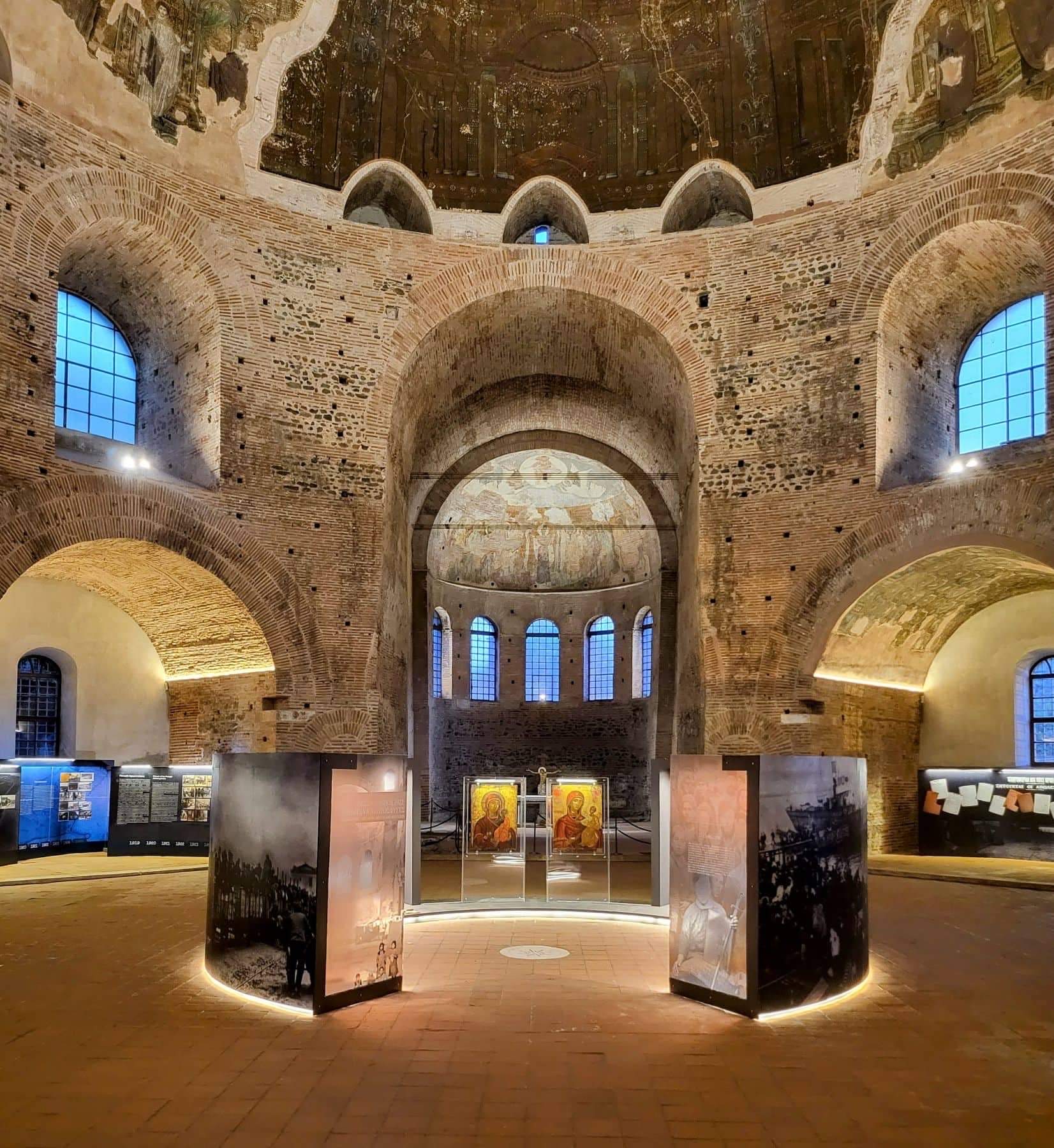
At the beginning of the 20th century, Thessaloniki was going through one of the most difficult decades of its history. The events that followed the liberation, such as the First World War, the fire of 1917, the arrival of refugees from Asia Minor, changed its face and determined its future. Its churches, converted into mosques (Agios Dimitrios, Agios Georgios, Agia Sophia, etc.), were consecrated and declared “national monuments” by royal decree in 1913.
Waves of refugees flock successively from war-torn areas (Eastern Thrace, Bulgaria, Serbia, Russia). They spread throughout the city, and the Byzantine churches, which had just returned to Christian worship, became places of settlement.
A fire in 1917 transformed its urban center. Thousands of homeless fire victims settle in public buildings and churches. Two years later, Hellenism begins the greatest refugee journey of the 20th century. For the third time in the decade 1912-1922. “The houses of God have become the houses of people,” says the head of the Ephorate of Antiquities of Thessaloniki, Elisabeth Tsigarida.
Accommodation for refugees
One of the most interesting commemorative exhibitions for the 100th anniversary of the catastrophe in Asia Minor, organized by the Ephorate of Antiquities of Thessaloniki, is approaching the scale of monuments as housing for refugees. In the symbolic monument of the Rotunda, the place that received the first refugees from the Balkans, rich photographic materials from state institutions and private archives, burnt household utensils from the fire finds, military uniforms of Asia Minor, suitcases of refugees are preserved. from the refugee’s great journey, newspaper clippings, flip through the decade and the events that marked it.

At the same time, they highlight the role played by the monuments and the human dimension of the temporary settlement in the “refugee” Thessaloniki, which received 52% of the 1.5 million exiled Greeks, as Flora Karagianni, curator of the exhibition and head of the Byzantine section informs us of the antiquities of Eforia. Approximately 350,000 refugees passed through Kalamaria’s disinfection centers, also known as sanatoriums. Those who escaped illness (22,000 people died) scattered throughout the villages of Macedonia, Thrace, developed on the outskirts of Thessaloniki (Kalamaria, Tumpa, Agia Foteini) and founded settlements in memory of unforgettable homelands, such as Cordelio, Menemeni, Xirocrini, etc. .a.
In the center of Thessaloniki, the refugees found temporary shelter in schools, stadiums, market stalls and at Eptapyrgio, on the city’s Acropolis, where they adapted makeshift buildings and modest houses to the Byzantine fortified walls and surrounding temples (Agios Nikolaos Sirota). , Prophet Elijah, Holy Apostles, Agia Haykaterini, Agios Minas) are concentrated on Panagia Achiropoitos – the only Byzantine monument that was not consecrated, as it was supposed to house the “Central Byzantine Museum”. They lived in the aisles, in niches, in the vestibules, in the palate, they gave birth to children there, they announced the addresses in the announcements to the churches in order to search for the missing relatives.
Photographs and relics of refugees from 1912-1922 are exhibited in the Rotunda.
Eighty families stayed in Achiropoitos for four years. The images around the Rotunda are shocking. Gods and straws, pots, hanging sheets and blankets demarcated their homes, and in the niche of the holy step, the icon of the Virgin Mary “Rheumatocratoress” from Rydesto in Eastern Thrace.
relics
The “Rheumatoid Empress” is described by Giorgos Ioannou in his short story of the same name (“Sarcophagus”, 1982): “My grandparents brought her from the state to Propontis. They grabbed her one Sunday morning and left on horseback. [..] After two or three days, constantly stretching to the west, they reached Evros and crossed the stream like a litany. The rheumatoid empress held back a lot of water again. In Thessaloniki, most of them were slaughtered in Achiropoitos or thereabouts. […] after they set up their image at the site of the sanctuary, they shared spaces like rooms with blankets and sheets, and began to live. Love affairs, fights, beatings, feasts, joys and birthdays took place behind hanging sheets that were lifted only when the event was of particular importance. During the carnivals, the pelecudi were burned.”
The Rheumatoid Empress and Heliocallis, brought by the Passengers, dominate the interior of the circular structure under the dome of the Rotunda. They are framed by 36 icons and church utensils from megalopolises and family heirlooms of thirteen descendants, antiquities with records-evidence of the inhabitants of the homeland before the resettlement. “May the holy God deliver us from what we have in those days when these scoundrels come to punish us,” they write and sign on one of the pages.
“The most touching aspect of the tragedy of the refugees is the rescue of relics that they either donated to temples or kept as monuments,” said Ms. Karagianni. “These desperate people, despite the forced flight, suffering and hardship, along with the most necessary minimum of survival, carried precious objects. They considered it their duty and, without knowing it themselves, saved the civilization of the Ionian land. Today, a hundred years later, all is lost. The only connection between the descendants of refugees and their ancestral home is family heirlooms. They immortalize the stories, keep the memory alive now and forever.”
“Thessaloniki 1922: Monuments and refugees” until 31 December.
Source: Kathimerini
James Springer is a renowned author and opinion writer, known for his bold and thought-provoking articles on a wide range of topics. He currently works as a writer at 247 news reel, where he uses his unique voice and sharp wit to offer fresh perspectives on current events. His articles are widely read and shared and has earned him a reputation as a talented and insightful writer.